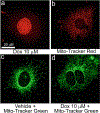Monitoring Mitochondrial Morphology and Respiration in Doxorubicin-Induced Cardiomyopathy
- PMID: 35771444
- PMCID: PMC11118012
- DOI: 10.1007/978-1-0716-2309-1_13
Monitoring Mitochondrial Morphology and Respiration in Doxorubicin-Induced Cardiomyopathy
Abstract
Doxorubicin (DOX)-induced cardiomyopathy constitutes dose-dependent cardiac toxicity, culminating in fatal heart failure progression. Cardiac toxicity limits effective and subsequent use of DOX in chemotherapy regimens in pediatric, adult, and recurrent cancer patients. DOX-induced profound alterations in mitochondrial morphology, dynamics, and defects in mitochondrial energy metabolism in the heart comprise key stressors in DOX-induced cardiotoxicity. Hence, the discovery of novel molecular targets and therapeutics to mitigate DOX-induced mitochondrial dysfunctions are imperative. Herein, we provided two laboratory protocols to monitor DOX-induced alterations in mitochondrial morphology and respiration in isolated primary neonatal rat cardiomyocytes. Neonatal rat cardiomyocytes are extensively used to monitor signaling mechanisms regulating cardiomyopathy in vitro. Therefore, these protocols will help researchers study the effects of novel pharmacological and genetic manipulations against DOX-induced alterations in mitochondrial morphology and energy metabolism in cardiomyocytes.
Keywords: Doxorubicin-induced cardiomyopathy; Mitochondrial morphology; Mitochondrial respiration; Oxygen consumption rates.
© 2022. The Author(s), under exclusive license to Springer Science+Business Media, LLC, part of Springer Nature.
Figures


Similar articles
-
Klotho attenuated Doxorubicin-induced cardiomyopathy by alleviating Dynamin-related protein 1 - mediated mitochondrial dysfunction.Mech Ageing Dev. 2021 Apr;195:111442. doi: 10.1016/j.mad.2021.111442. Epub 2021 Feb 1. Mech Ageing Dev. 2021. PMID: 33539906
-
SESN2 protects against doxorubicin-induced cardiomyopathy via rescuing mitophagy and improving mitochondrial function.J Mol Cell Cardiol. 2019 Aug;133:125-137. doi: 10.1016/j.yjmcc.2019.06.005. Epub 2019 Jun 12. J Mol Cell Cardiol. 2019. PMID: 31199952
-
Metallothionein rescues doxorubicin cardiomyopathy via mitigation of cuproptosis.Life Sci. 2025 Feb 15;363:123379. doi: 10.1016/j.lfs.2025.123379. Epub 2025 Jan 8. Life Sci. 2025. PMID: 39793852
-
Evolution of Theories on Doxorubicin-Induced Late Cardiotoxicity-Role of Topoisomerase.Int J Mol Sci. 2024 Dec 18;25(24):13567. doi: 10.3390/ijms252413567. Int J Mol Sci. 2024. PMID: 39769331 Free PMC article. Review.
-
Autophagic dysregulation in doxorubicin cardiomyopathy.J Mol Cell Cardiol. 2017 Mar;104:1-8. doi: 10.1016/j.yjmcc.2017.01.007. Epub 2017 Jan 17. J Mol Cell Cardiol. 2017. PMID: 28108310 Review.
Cited by
-
Resveratrol activation of SIRT1/MFN2 can improve mitochondria function, alleviating doxorubicin-induced myocardial injury.Cancer Innov. 2023 Mar 30;2(4):253-264. doi: 10.1002/cai2.64. eCollection 2023 Aug. Cancer Innov. 2023. PMID: 38089747 Free PMC article.
-
Deletion of Sigmar1 leads to increased arterial stiffness and altered mitochondrial respiration resulting in vascular dysfunction.Front Physiol. 2024 Apr 29;15:1386296. doi: 10.3389/fphys.2024.1386296. eCollection 2024. Front Physiol. 2024. PMID: 38742156 Free PMC article.
References
-
- Bonadonna G, Monfardini S, De Lena M, Fossati-Bellani F, Beretta G (1970) Phase I and preliminary phase II evaluation of adriamycin (NSC 123127). Cancer Res 30(10): 2572–2582 - PubMed
-
- Sledge GW, Neuberg D, Bernardo P, Ingle JN, Martino S, Rowinsky EK, Wood WC (2003) Phase III trial of doxorubicin, paclitaxel, and the combination of doxorubicin and paclitaxel as front-line chemotherapy for metastatic breast cancer: an intergroup trial (E1193). J Clin Oncol 21(4):588–592 - PubMed
-
- Kremer LC, van der Pal HJ, Offringa M, van Dalen EC, Voute PA (2002) Frequency and risk factors of subclinical cardiotoxicity after anthracycline therapy in children: a systematic review. Ann Oncol 13(6):819–829 - PubMed
-
- Steinherz L, Steinherz P (1991) Delayed cardiac toxicity from anthracycline therapy. Pediatrician 18(1):49–52 - PubMed
Publication types
MeSH terms
Substances
Grants and funding
LinkOut - more resources
Full Text Sources
Medical

